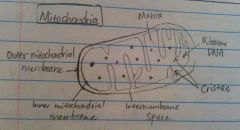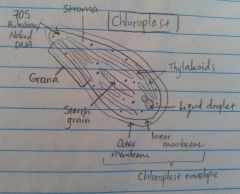![]()
![]()
![]()
Use LEFT and RIGHT arrow keys to navigate between flashcards;
Use UP and DOWN arrow keys to flip the card;
H to show hint;
A reads text to speech;
18 Cards in this Set
- Front
- Back
|
Compare & Contrast Competitive & Non-Competitive Inhibition (8) |
Differences: 1) Fits onto active site 2) Competes with substrates for AS Doesn't compete with substrates 3) Inhibits via taking active site Inhibits via causing conformational change 4) Doesn't change max rate of reaction Lowers max rate of reaction 5) Takes more concentration of substrate to achieve max rate Similarities: - Both, as concentration of inhibitor increases, rate of reaction decreases - Both detach from the enzyme after attaching - Both prevent the substrate from binding to the enzyme |
|
|
Define - Metabolic Pathways - End Product Inhibition |
Metabolism: The sum of all chemical reactions that occur within an organism Metabolic Pathway: Cycles/chain of enzyme catalyzed reactions; the sum of the small steps which cause molecules to change into other molecules End Product Inhibition: When a metabolic pathway is blocked because the end product inhibits the first enzyme of the pathway. |
|
|
Give an example of End Product Inhibition |
Isoleucine (an essential AA) - Bacteria synthesizes isoleucine from threonine in 5 enzyme-catalyzed steps - As isoleucine concentration increases, some bind to the allosteric site of 1st enzyme (threonine deaminase) - Pathway then turned off w/ enough concentration - If concentration falls (when AA used) the allosteric sites are emptied & pathway opened again |
|
|
Explain Oxidation and Reduction Reactions (defs + 2) |
Oxidation: Reduction: electrons and H+ gained, O2 removed - Think OILRIG - When one reaction happens, the other one happens as well |
|
|
Explain how Oxidation/Reduction relates to Respiration & Photosynthesis |
Both pathways use electron carriers which constantly oxidize & reduce Respiration: - Kreb's Cycle: NAD+ and FAD reduce to NADH and FADH2 - ETC: electron carriers above oxidize & release electrons & H Photosynthesis: - LD: via Ferredoxin, NADP+ reduce to NADPH - LI (Calvin Cycle): NADPH oxidize to NADP+ |
|
|
Why is O2 Important In Aerobic Respiration? (4) |
- O2 is the terminal electron acceptor - O2 "cleans out" the H+ and excess electrons during Chemiosmosis - Maintains the concentration gradient between matrix and Inter-membrane space - Allows ATP to continue to be produced |
|
|
Compare & Contrast the Structure & Function of Mitochondria & Chloroplasts (10) |
Differences: 1) Has cristaes (attached to inner membrane) Has Thylakoids (not attached) 2) Don't have pigment molecues 3) Integral membranes not arranged in stacks Are arranged in stacks (Grana) 4) Produces ATP via aerobic respiration Produces via photo-phosphorylation 5) Purpose = ATP production Purpose = glucose production Similarities: - Both have inner & outer membranes - Both have 70S Ribosomes & Naked DNA - Have Integral membranes (cristae/thylakoids) - Produce ATP, have electron transport & ATP Synthase - Both use a small V-SA ratio to utilize a proton gradient (chemiosmosis) |
|
|
Annotated Drawing of Mitochondria (6) |

|
|
|
Annotated Drawing of Chloroplast (9) |

|
|
|
Compare & Contrast the Metabolic Pathways of Photosynthesis & Aerobic Respiration (9) |
Differences: 1) Involves photons/light to activate enzymes Doesn't require light 2) Cycle (Calvin) = carboxylation (carbon fixation) Cycle (Krebs) = decarboxylation 3) End product = glucose End product = ATP 4) Initial Reactants = 6CO2 + 6H2O 5) Starts with ATP Production (LR) Ends with ATP Production (Oxidative phosphorylation) Similarities - Both involved ATP Synthase - Both involve creating H+ for a reactant in a later enzyme - Both involved the flow of electrons from one protein to another - Both involve cycles which regenerate the final product back to the initial reactants |
|
|
Compare & Contrast Aerobic & Anaerobic Respiration (10) |
Differences: 1) Occurs in mitochondria Occurs in cytoplasm 2) Large yield of ATP (34) Small yield (2) 3) Requires O2 Doesn't 4) Produces ATP slower Produces faster 5) Byproducts same for all organisms Different per organism 6) Goes through a metabolic pathway Doesn't Similarities - Both produce ATP - Both yse glycolysis (produce pyrobates) - Both start w/ glucose - Both produce CO2 as a byproduct |
|
|
Compare & Contrast Light Dependent and Independent Reactions (8) |
Differences 1) Requires light (photolysis) Doesn't require light 2) Takes place in inter-membrane space of thylakoids Takes place in stroma 3) Doesn't rely on products of another reaction Relies on LD products 4) Produces ATP Produces glucose Similarities - Both involved in photosynthesis - Both rely on enzymes - Both take place within the chloroplast - Both are metabolic pathways |
|
|
How do enzymes lower the activation energy of a reaction? |
When the substrate binds to the active site of an enzyme, the binding causes the bonds to become stressed, lowering the activation energy |
|
|
Name the Steps and Explain them in Respiration (Also location) (3, 3, 5, 4, 4) |
1) Glycolysis - Cytoplasm - Glucose is phosphorylated via 2 ATP (hexo phosphate) and then splits into two triose phosphates - H is oxidized out (reducing NAD) creating 2 pyrobates - 4 ATP are produced total from the released energy of the pyrovates 2) Link Reaction - Matrix - An enzyme removes one CO2 (decarboxylation), reducing NAD at the same time and producing an acetyl group - The acetyl group reacts to coenzyme A (a carrier), forming acetyl CoA - remember this happens twice 3) Kreb's Cycle - Matrix - CoA deposits the acetyl group and joins it with a 4C sugar to form a 6C sugar - The 6C sugar is oxidative decarboxylated twice (reducing 2 NAD), becoming a 4C sugar - Its bonds are rearranged, reducing NAD & FAD as well as causing substrate-level phosphorylation (produce ATP) - Then the 4C is added to an acetyl group, creating the cycle - Net yield (from one glucose) = 2 ATP, 2 FADH2, 6NADH + H 4) Electron Transport Chain - Inner Membrane - NADH +H oxidizes/deposits H+ and e- at first channel, FADH2 deposits at second - e- activate channel & pump H to inter-membrane space - e- then move to 2nd channel & activate it, pumping the H there - e- move and stop at the stop point 5) Chemiosmosis - Inner Membrane - The H move from the inter-membrane space to the matrix via ATP Synthase (chemiosmosis) - Because of flow ATP is produced - Potential of 32 produced - O2 then comes and carries e- and H |
|
|
What are the Electron Carriers for: - Respiration - Photosynthesis (3) |
Respiration: - FAD (which reduces to FADH2) Photosynthesis: - NADP+ (which reduces to NADPH) |
|
|
Name the General Steps and Explain them in Photosynthesis (Also location) (7, 4) |
1) Light Dependent Reactions - Thylakoid Membrane - Light energy activates e- in chlorophyll of photosystem II (PSII) - e- move via electron carrier to proton pump - A hydrolytic enzyme in PSII splits H2O into separate components - H (from ID) pumped via pump to thylakoid space - Chemiosmosis causes ATP Synthase to produce ATP - Light energy activates e- in PSI which (with the other e- from PSII) are received by Ferredoxin - Ferredoxin reduced NADP with e- and H that came from thylakoid space, maintaining the concentration gradient 2) Light Independent Reactions (Calvin Cycle) - Stroma - RuBP carboxylated with CO2 via rubisco - The unstable 6C immediately splits to 2 glycerate 3-phosphates (g3p) - The 2 g3p are reduced via 2ATP and 2NADPH to 2 triose phosphates - Two things happen at this point: 5/6 cycles the triose phosphates are regenerated back into RuBP to continue the cycle (using ATP) 1/6 cycles the triose phosphates are linked to form glucose |
|
|
Explain how the Structure of Chloroplasts adapted for its Function (3 w/ general structure) |
Thylakoid membranes: - large SA for light absorption - folds allow photosystems (groupings of chlorophyll and other pigments) / e- carriers to be close together Thylakoid spaces: - Low V enables rapid H concentration gradient |
|
|
Explain how Light Wavelengths affect Rate of Photosynthesis (4) |
Plants have pigments (usually chlorophyll) which absorb wavelengths used for light-dependent reactions (photolysis). - The useful wavelengths plants absorb are around 400 nm or 800 nm (violet or red) and those outside that range (green) are reflected by plants - Plants absorb these wavelengths because the lower wavelengths have more energy and the higher ones are most efficient to absorb. - Because photosynthesis only uses specific ranges of light, the wavelengths of the light can enhance or inhibit the process. |

